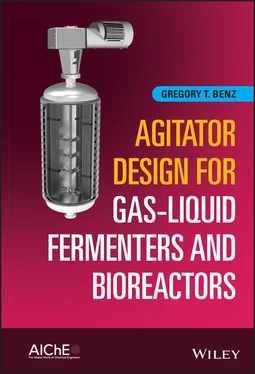Note that evolving gas from solution is a separate issue from dispersing gas. Evolving gas is already dispersed, though it affects power draw, performance, and mechanical behavior in a similar way to dispersing gas.
Define Process Conditions
All conditions impacting the agitator design, the mass transfer rate, and ancillary functions such as heat transfer must be delineated. A partial list follows:
Fluid density (e.g. specific gravity or density such as kg/m3)
Fluid viscosity (e.g. cP or Pa‐s). If the fluid is non‐Newtonian, the model and parameters describing it must be included
Operating temperature
Mean barometric pressure
Back pressure in vapor space
Heat capacity of the process fluid at constant pressure, CP. Sample units J/g‐C or BTU/lb‐F
Thermal conductivity of the process fluid, k. Sample units J/h‐m‐C or BTU/h‐ft‐F.
For the ancillary heat transfer calculations, need the above thermal properties for the heat transfer medium as well
For the heat transfer calculations, need the available flow and temperature of the heat transfer medium
Concentration of oxygen (or other species to be transferred) in the feed gas (usually, we will assume air at 21% oxygen)
Henry’s law constant, or alternatively, saturation concentration at feed gas concentration at process temperature at a reference pressure (typically 1 atm)
Minimum required dissolved oxygen concentration for organisms to thrive
Maximum allowable CO2 concentration in the exit gas, either as mole fraction or as actual partial pressure
Any other process constraints affecting design
In principle, many tank shapes can be used. That can include cylindrical, rectangular, and spherical tanks. However, odd‐shaped tanks may be hard to baffle and agitate properly. Rectangular tanks may be harder to clean and sterilize if they have sharp corners. Most tanks used in this industry are cylindrical. Most are mounted with their axis vertical. However, the author knows of at least one installation where a multitude of horizontal cylindrical tanks were used. This is decidedly not recommended, for a host of reasons. Just a few worth mentioning: Multiple gear drives per tank are required, increasing agitator cost. Very random hydraulic forces occur, causing more frequent mechanical failure. Low absolute liquid height fails to take advantage of higher oxygen solubility at the bottom of the tank due to liquid head. Harmonic flows in the sparge system can occur.
For the purposes of this book, we will stick to vertical cylindrical tanks. With that restriction, the geometry to be decided is the ratio of liquid height to tank diameter (Z/T), often referred to as aspect ratio. Fermenters have been built with a wide variety of aspect ratios, for various reasons. The most common or popular designs normally have aspect ratios between 2 and 3, but that may be more related to tradition than because it is optimum for a particular set of circumstances.
Chapter 19discusses aspect ratio in detail, in terms of its effect on capital and power costs, which provides an opportunity for optimization. However, we have to begin somewhere to go through the rest of this flow chart. In the absence of any restrictions on geometry, an aspect ratio between 2 and 3 seems reasonable to start with.
There can be restrictions on aspect ratio due to building constraints. If the vessel must fit within a given floor space, that may place restrictions on the diameter, forcing a certain minimum aspect ratio. Sometimes, local building codes carry height restrictions. So, the allowable aspect ratio range may be bound by such constraints, among others.
Calculate Equivalent Power/Airflow Combinations for Equal Mass Transfer Rate
It is possible to achieve the same mass transfer rate using a small amount of air and a lot of agitator power, or a lot of air with low agitator power, and an infinite number of steps between.
There are upper and lower airflow limits, however. The minimum airflow is where the OTR is stoichiometrically balanced; that is, the molar flow of oxygen in the incoming air stream exactly matches the molar rate of consumption. In other words, this would require 100% mass transfer. That would require an infinite amount of agitator power!
The upper bound would be when either the vessel or the agitator is flooded. We will define these conditions in Chapters 4and 8. Suffice it to say for now that there is such a thing as too much airflow.
To keep calculation effort reasonable, the calculations should be performed incrementally: say, starting with 25% more than the minimum and stepping in about 5‐10% increments on that, up to the maximum.
Chapter 8describes this procedure in detail.
Choose Minimum Combined Power
From the above combinations of agitator power and airflow, calculate the agitator brake power, which is the shaft power divided by the mechanical efficiency of the agitator, which includes gear drive losses as well as seal losses. Calculate the compressor brake power, including pressure losses through lines, filters, and sparger as well as compressor efficiency. Add the agitator and compressor brake power together and choose the combination with the lowest total, unless other constraints govern, such as CO 2in the exhaust gas.
Choose Shaft Speed; Size Impeller System to Draw Required Gassed Power
It is possible to invest the same power at different shaft speeds by using different impeller sizes. In essence, high shaft speeds use smaller impellers and low shaft speeds use larger impellers. There are process, mechanical, and cost implications to this decision, as described in Chapters 6and 17and Ref. [2]. So, when we choose an initial speed, we may have to go back and choose another, as in the decision diamonds in Figure 2.1.
Though not all gear drives match the American Gear Manufacturer’s Association (AGMA) standard speeds, they are a good place to start, prior to engaging in detailed mechanical design. The speeds relevant for agitator design, in rpm, are 30, 45, 56, 68, 84, 100, 125, 155, 190, 230, 280, and 350 rpm. Laboratory units may have considerably higher speeds than this range.
Decision Point: D/T and Gassing Factors OK?
As described in Chapter 6, D/T has effects on power, performance, and gassing factors (gassing factor is the ratio of power draw in the gassed condition to that in the ungassed condition). For example, we have found that designs requiring a D/T of more than 1.0 are unlikely to be successful. In general, smaller D/T ratios have less impact of gas flow changes on power draw than large ones, but create a less uniform bubble size and may be difficult to design mechanically. Also, the need for internal heat transfer surfaces may limit the maximum D/T.
If the chosen shaft speed causes problems with gassing factors or mechanical interference, go back and choose a different shaft speed. If it is OK, go to the next step.
This actually involves several things. It includes how the agitator is to be mounted ( Chapter 16), gear drive selection and shaft/impeller design ( Chapter 17). Some designs may not be feasible due to shaft critical speed or a complex shaft design, such as one requiring multiple steady bearings. The mechanical design at the chosen shaft speed should be deemed feasible or not.
Decision Point: Is the Mechanical Design Feasible?
If the answer is no, go back and try a different shaft speed and repeat until one or more feasible designs are found.
Repeat to Find Lowest Cost
There may be several mechanically feasible designs at different shaft speeds. These different designs may have different costs. Higher speed means less torque and a less expensive gear box. However, the shaft design may be more expensive. There is no straightforward rule of thumb for this; each design must be fleshed out and a cost estimate made. In general, we would choose the least capital cost design unless there are other constraints. Once a semi‐final design is selected (for the entire optimization process we go through here, not just shaft speed), equipment vendors are generally helpful in optimizing capital cost.
Читать дальше












